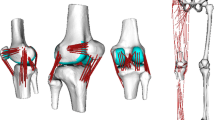Abstract
The musculoskeletal model developed in this work is an improvement over previous models in two respects. First, the model is three-dimensional, and includes a detailed description of both patellofemoral and tibiofemoral mechanics. Second, and perhaps more significantly, the model takes into account the effects of both musculotendon properties and musculoskeletal geometry on calculations of ligament and articular-contact forces transmitted at the knee. The model presented here not only incorporates the force-length properties of all the major extensor and flexor muscles of the knee, but it also represents the path of each actuator more precisely. Simulations of maximum isometric knee extension and knee flexion were used to explain the variation in cruciate ligament loading at the knee resulting from the interaction between the external forces applied to the bones, the action of the muscles, and the articular-contact forces transmitted through the joint.
Similar content being viewed by others
References
Beynnon, B. D., Fleming, B. C., Johnson, R. J., Nicoles, C. E., Renstrom, P. A., and Pope, M. H., 1995, “Anterior Cruciate Ligament Strain Behavior During Rehabilitation Exercises In vivo,”Am. J. Sports Med., Vol. 16, pp. 113–122.
Butler, D. L., Noyes, F. R., Grood, E. S., 1980, “Ligamentous Restraints to Anterior-Posterior Drawer in the Human Knee,”J. Bone Jt. Surg., Vol. 62-A, pp. 259–270.
Collins, J., and O’Connor, J., 1991, “Muscle-Ligament Interactions at the Knee During Walking,”Proc. Instn. Mech. Engrs., Part H, 205, pp. 11–18.
Daniel, D. M., Stone, M. L., and Riehl, B., 1988, “Use Of the Quadriceps Active Test to Diagnose Posterior: Cruciate Ligament Disruption and Measure Posterior Laxity of the Knee,”J. Bone Jt. Surg., Vol. 70A, pp. 386–391.
Delp, S. L., 1990, “Surgery simulation: A Computer Graphics System to Analyze and Design Musculoskeletal Reconstructions of the Lower Limb,” Ph. D. Thesis, Dept. of Mechanical Engineering, Stanford University.
Durselen, L., Claes, L., and Kiefer, H., 1995, “The Influence of Muscle Forces and External Loads on Cruciate Ligament Strain,”Am. J. Sports Med., Vol. 23, pp. 129–136.
Freiderich, J. and Brand, R. A., 1990, “Muscle Fiber Architecture in the Human Lower Limb,”J. Biomechanics, Vol. 23, pp. 91–95.
Hefzy, M. S. and Grood, E. S., 1988, “Review of Knee Model,”Appl. Mech. Rev., Vol. 41, pp. 1–13.
Hirokawa, S., Solomonow, M., Lu, Y., Lou, Z., and D’Ambrosia, 1992, “Anterior-Posterior and Rotational Displacement of the Tibia Elicited by Quadriceps Contraction,”Am. J. Sports Med., Vol. 20, pp. 299–306.
Kim, S., 1998. “Three-Dimensional Dynamic Model of the Human Knee,” KSME International Journal Vol. 12, No. 6.
Kim, S., 1996, “A Three-Dimensional Dynamic Musculoskeletal Model of the Human Knee Joint,” Ph.D. Dissertation., Mechanical Engineering Dept. The University of Texas at Austin, TX. U. S. A.
Markolf, K. L., Gorek, J. F., Kabo, M., et al., 1990, “Direct Measurement of Resultant Forces in the Anterior Cruciate Ligament,”J. of Bone Jt. Surg., Vol. 72-A, pp. 557–567.
Pandy, M. G., Zajac, F. E., Sim, E., and Levine, W. S., 1990, “An Optimal Control Model for Maximum-Height Human Jumping,”J. Biomechanics, Vol. 23, pp. 1185–1198.
Renstrom, P., Arms, S., Stanwyck, T., Johnson, R., and Pope, M., 1986, “Strain Within the Anterior Cruciate Ligament During Hamstrings and Quadriceps Activity,”Am J Sports Med., Vol. 14, pp. 83–87.
Shelburne, K. B. and Pandy, M. G., 1997, “A Musculoskeletal Model of the Knee for Evaluating Ligament Forces During Isometric Contractions,”J. Biomechanics, Vol. 30, pp. 163–169.
Wascher, D. C., Markolf, K. L., Shapiro, M. S., and Finerman, G. A., 1993, “Direct In vitro Measurement of Forces in the Cruciate Ligaments. Part 1: The Effect of Multiplane Loading in the Intact Knee,”J. Bone Jt. Surg., Vol. 75-A, pp. 377–386.
Zavatsky, A. B. and O’Connor, J. J., 1993, “Ligament Forces at the Knee During Isometric Quadriceps Contractions,”Proc. Instn Mech Engrs., Part H 207, pp. 7–18.
Author information
Authors and Affiliations
Rights and permissions
About this article
Cite this article
Kim, S. Muscle-ligament interactions at the human knee (I). KSME International Journal 12, 1079–1089 (1998). https://doi.org/10.1007/BF02942581
Received:
Issue Date:
DOI: https://doi.org/10.1007/BF02942581




